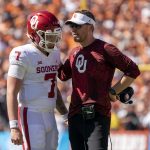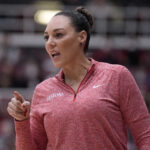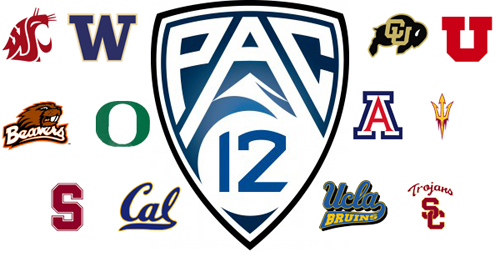The Hotline mailbag is published on Fridays. Send questions to pac12hotline@bayareanewsgroup.com or hit me on Twitter: @WilnerHotline. Due to volume — and in some cases, the need for research — not all questions will be answered the week of submission. Thanks for your understanding.
Some questions have been edited for clarity and brevity.
Thoughts on commissioner George Kliavkoff so far: What has he done well, and what does he still need to address? — @cooterbobjim
Everything, and everything.
Kliavkoff has been on the job for six-and-a-half months and deserves high marks for managing the issues within his control … from generating alignment with the campuses and admitting what he doesn’t know to supporting competitive endeavors and examining new football strategies … from navigating the expansion tumult last summer — and making sure the Pac-12 didn’t get poached — to positioning the conference within the ongoing playoff expansion debate.
(And there are numerous other examples).
Now, here’s the list of issues that are entirely or partly beyond Kliavkoff’s control:
— Implementation of name, image, likeness (NIL) legislation
— NCAA refusal to provide oversight of NIL legislation
— Texas and Oklahoma joining the SEC
— Number of 300-pound defensive linemen in the Pac-12 footprint
— Pac-12 football night games
— Pac-12 Networks distribution
— Pac-12 media revenue
— Beating BYU, Utah State and San Diego State
— COVID protocols at state and local levels
— Timing of College Football Playoff expansion (unanimous vote required)
— Timing of alliance-based games (depends on the Big Ten)
— Campus-specific resource allocations for football
— Defending Jaxon-Smith Njigba
The Pac-12 is facing a barrage of challenges, some beyond its control and some self-inflicted.
But most fall into one of two categories: 1) They are campus-specific and beyond the commissioner’s purview, or 2) They are within the commissioner’s purview but pre-date Kliavkoff’s tenure.
In fact, all of the challenges fall into one of those categories.
Kliavkoff’s work on most major issues to this point has focused on preparing to execute when his chance arrives, in particular with the media rights negotiations — the most important issue that will fall within his control.
One reason the presidents initiated the commissioner change when they did was to provide Larry Scott’s successor with the time necessary to craft a media rights strategy before negotiations begin in early 2023. Our strong hunch is Kliavkoff will be ready to maximize the opportunity.
Let’s frame everything a different way:
Had we known back on July 1 the course that events would take, the Hotline would have declared Kliavkoff’s first six months a success while quoting famed Caddyshack prognosticator Carl Spackler:
“I don’t think the heavy stuff’s gonna come down for quite a while.”
Will the university presidents give serious consideration to Kliavkoff’s request that the schools invest in football? — @EngelKRichard
The question refers to Kliavkoff’s plan to convince the presidents and chancellors of the high return-on-investment potential football carries for the campus writ large.
USC and Oregon have made the commitment, clearly. But it’s not a one-size-fits-all situation. Each school, each president, must determine a reasonable level of investment based on campus economics. Washington State’s budget isn’t USC’s budget. Arizona’s budget isn’t Oregon’s budget.
Our guess is that most of the schools will heed Kliavkoff’s advice, in part because the presidents have a vested interest in his success … and his success is tied closely to football’s success.
But based on what we have seen over the years, it’s reasonable to wonder if a few presidents and chancellors — we won’t name names, yet — are willing to make the necessary commitment to compete for playoff bids.
The answers won’t become clear for several years, so let’s not rush to judge. But the situation warrants extreme scrutiny.
Which Pac-12 players have the best opportunities to be drafted in the early rounds? Which football pre-draft games are ranked the most prestigious? — @markscalcido
The answer to the second question first: The Senior Bowl, on Feb. 5, is the game to watch — it’s the only pre-draft competition, in fact. The remainder of the draft calendar is occupied by workouts at the scouting combine in Indianapolis and on campus.
The Pac-12 has several first-round prospects, with Oregon edge rusher Kayvon Thibodeaux, Utah linebacker Devin Lloyd, Washington cornerback Trent McDuffie and USC receiver Drake London atop our list.
Lloyd has committed to playing in the Senior Bowl, by the way.
Is there a bigger conference game on the football schedule in 2022 than Utah vs. USC? — @benwilkinson
If you presume Utah is the clear frontrunner for the conference title, then it stands to reason the biggest game(s) will involve the Utes.
That could very well be USC’s visit to Rice-Eccles Stadium in the middle of October, if the Trojans emerge under Lincoln Riley as a division contender and are a ranked opponent at the time of kickoff.
The other obvious option for Pac-12 conference game of the year is Utah’s date at Oregon — partly because the Ducks appear to have a championship-caliber roster and partly because the showdown comes on the penultimate weekend of the regular season, as it did in 2021.
A playoff path might be available to the winner.
Thoughts on length of a new contract for UCLA coach Chip Kelly? — @Neilschoolnik
Who would you hire as defensive coordinator at UCLA? Jimmy Lake? — @solarschmidt
Although it’s hardly guaranteed, my guess is that the Bruins and Kelly will agree to an extension of either three or four years, in addition to the one year remaining on his original deal.
In other words, he will be signed through the 2025 or 2026 seasons.
The key isn’t the annual compensation so much as the buyout terms, in case things turn sideways quickly. How much would the Bruins owe Kelly if, for example, the losses pile up and they make a change just two years from now? They cannot mortgage the future given the athletic department’s massive load of accumulated debt (in excess of $40 million at last count).
If a new deal is reached, check the duration, check the annual salary and then pay close attention to the school’s long-term liability.
As for the defensive coordinator role, I’m not sure Jimmy Lake is the right hire right now — it could be too soon for him to join any staff given the inflammatory course of events in Seattle.
Admittedly, we have not performed a deep dive on coordinator candidates for the Bruins, but three names come to mind as potential candidates:
San Diego State defensive coordinator Kurt Mattix; Utah assistant Louis Powell, who works with defensive ends; and Miami Dolphins secondary coach Gerald Alexander, who’s from L.A. and spent three years at Cal under Justin Wilcox.
Are there worrisome signs with Stanford and the transfer portal? Losing the top two tailbacks (Austin Jones and Nathaniel Peat), each after their third year, seems odd. Unless they’re extremely accelerated academically, it looks like they might even be leaving before they get their degrees, which would be even more odd. — @WorkishFromHome
The signs are indeed worrisome on multiple levels. The Cardinal’s depth at the position has been severely impacted by the moves, and finding replacements in the transfer portal is exceedingly difficult for the program.
But the transfers speak to a larger issue: It’s depressing to be a running back for a team that cannot run the ball.
Stanford was 126th in the country in rushing yards per game last season. Peat averaged 5.1 yards per rush but only 6.6 carries per game, and Jones averaged just 3.5 yards per attempt.
Those numbers speak to yet another, even larger issue: Because of its recruiting pool, Stanford’s success in the Pac-12 hinges on its ability to run the ball. It cannot thrive consistently with a pass-oriented attack.
In 2017, the Cardinal averaged more than 200 yards per game on the ground and won the North.
In 2021, it averaged less than 100 yards per game on the ground and finished last in the North.
There are numerous reasons for the decline, but the disappearance of the running game is near the top of the list.
What is the impact of receivers coach JaMarcus Shephard coming to Washington? — @trevormuellersi
First and foremost, it’s a psychological boost for the team and the fans to have a coveted assistant joining the program after so many questionable hires over the past two or three years.
And Shephard was indeed coveted after his impressive work at Purdue in recent seasons, where he learned from a first-rate head coach (Jeff Brohm) and developed several top-tier wideouts, including Rondale Moore.
Our view is fairly straightforward: Washington’s receivers have underperformed for years. The situation can’t get worse under Shephard and, most likely, will get much better.
Any sign of regulation for name, image and likeness? For instance, a team that is steeped in oil money might want to swoop in and lure away a transfer from Florida for, say, $100,000. — @troychilton
No signs of regulation. None. Zero. And if the rumors we hear are half true, the amount of money spent acquiring players — and using NIL as unregulated cover for old-fashioned cheating — is in the millions of dollars for some schools.
Support the Hotline: Receive three months of unlimited access for just 99 cents. Yep, that’s 99 cents for 90 days, with the option to cancel anytime. Details are here, and thanks for your support.
*** Send suggestions, comments and tips (confidentiality guaranteed) to pac12hotline@bayareanewsgroup.com or call 408-920-5716
*** Follow me on Twitter: @WilnerHotline
*** Pac-12 Hotline is not endorsed or sponsored by the Pac-12 Conference, and the views expressed herein do not necessarily reflect the views of the Conference.
Related posts:
 Wilner Hotline: Five Need-to Knows for Week Four
Wilner Hotline: Five Need-to Knows for Week Four
 Wilner Hotline – Thanksgiving Day Pac-12 Doings
Wilner Hotline – Thanksgiving Day Pac-12 Doings

Oklahoma head coach Lincoln Riley . (AP Photo/Jeffrey McWhorter)
Wilner Hotline – Lincoln Riley To USC Sends Shock Waves Through Pac-12
Arizona head coach Adia Barnes (AP Photo/Tony Avelar)
Metcalfe Pac-12 WBB notebook: Stanford sweeps ranked LA schools, Utah splits despite Pili injury, Arizona back in bye position

